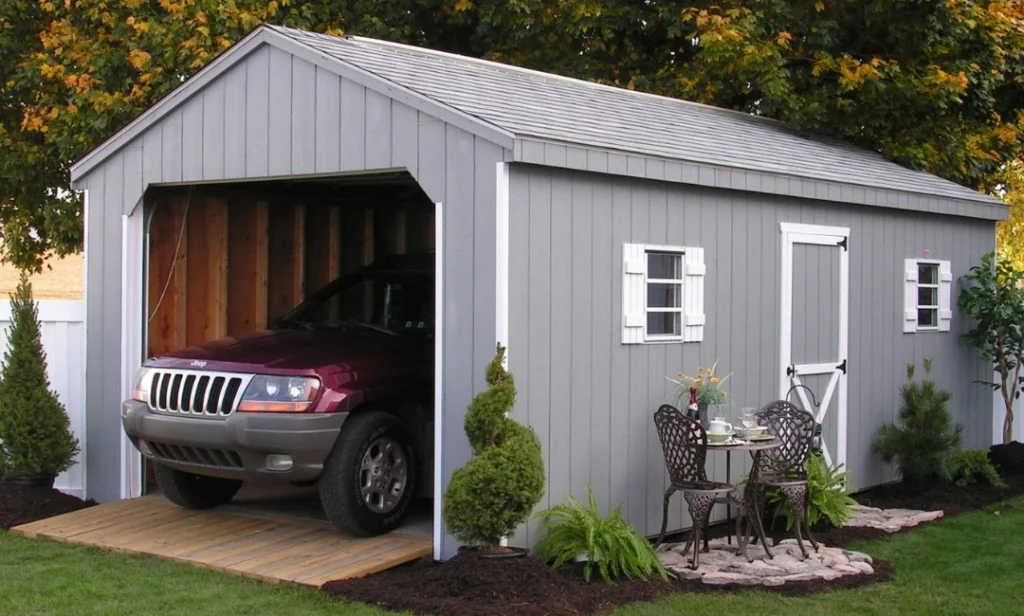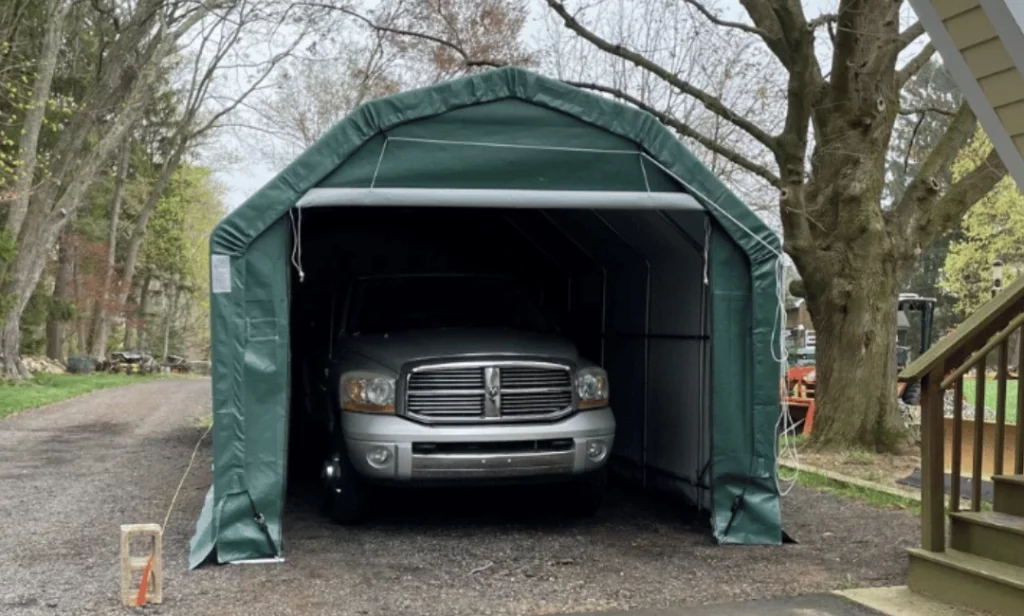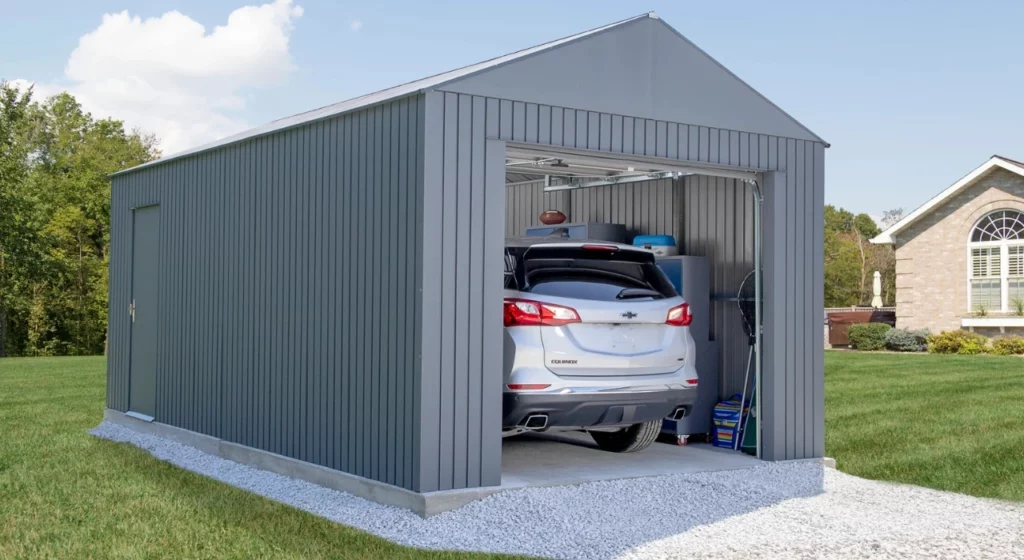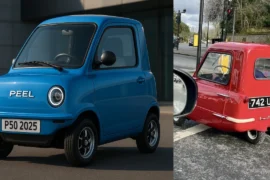Temporary car shelters are an easy and affordable solution to keep your car or RV safe from bad weather all year long. However, in regions with heavy snowfall, winter conditions can strain these structures. If the garage isn’t built to handle snow weight, snow accumulation can lead to sagging or collapse. Snow load refers to the maximum weight the roof can safely support before it becomes unsafe.
For people who own cars, use RVs, or live in cold-weather areas, it’s important to choose a garage that can handle the weight of snow. Overlooking this can result in damage and repair costs. This article explains how much snow a temporary car garage can support, what affects its snow load capacity, and how to choose a shelter suited for your local winter conditions.
What Is Snow Load Capacity?
Snow load capacity is how much weight from snow a structure can hold without breaking. It’s measured in pounds per square foot (PSF) and is important for roofs.
There are two kinds of loads to consider
- Live load – temporary forces like snow, rain, or wind
- Dead load – the permanent weight of the structure, such as the roof, walls, and frame
Snow load is a type of live load caused by snow falling on a roof. In areas where it snows a lot, snow can pile up fast. If a temporary car shelter isn’t built to handle the snow load in your area, it might not stay strong. Knowing the snow load capacity helps people who own cars, RVs, or homes choose the right shelter for their local winter weather. A properly rated garage ensures the roof can hold the weight of snow safely, preventing structural damage.
Types of Temporary Car Garages and Materials Used

The ability of a temporary car garage to handle snow depends mostly on the materials used and how it’s built. In areas with lots of snow, choosing the correct frame, covering, and roof shape is important for making sure the structure stays safe over time.
1. Frame materials
Steel frames are the strongest option for winter. Galvanized steel, especially in 14–16 gauge, is very strong and can support more snow. Aluminum frames are lighter and easier to work with but can’t hold up as well under heavy snow pressure. Plastic or PVC frames are not good for snowy areas because they aren’t strong enough.
2. Cover materials
Polyethylene is a popular and cost-effective option. It can resist water and sunlight but might stretch or wear out with heavy snow. PVC or vinyl-coated fabric is more durable and better for cold weather. It holds up better under snow and lasts longer in cold conditions.
3. Roof design
Roofs that are peaked or gable-shaped help snow slide off more easily, which reduces the weight on the frame and improves how well the structure handles snow. Flat or gently sloped roofs collect more snow, which can lead to problems like sagging or even collapse.
Picking the right mix of frame strength, cover type, and roof shape helps car owners, RV users, and homeowners choose a shelter that can deal with local winter conditions and keep the temporary car garage safe from heavy snow loads.
Suggestion: Upgrade Your Car’s Look With These Brown-Interior Color Combos.
Average Snow Load Capacity of Temporary Garages
Snow load capacity for temporary car garages is determined by the strength of the frame, the material used for covering, and the overall design. Most garages have a capacity ranging from 10 to 60 or more PSF (pounds per square foot),
Garages made with lightweight plastic frames and PVC covers typically handle 10 to 15 PSF, which works well for areas with light snow. Mid-range options that use steel frames and polyethylene (PE) covers can support 20 to 30 PSF, making them suitable for moderate snowfall.
Heavy-duty shelters built with reinforced steel and vinyl-coated fabric (PVC) can handle 40 to 60+ PSF.
Some garage models clearly state their snow load rating, but many budget options don’t. Always check the product specs before buying, especially if you live in places with heavy snow like Alaska, Colorado, or northern New York.
Understanding average snow load capacity helps car owners, RV enthusiasts, and homeowners choose a shelter that matches local winter conditions. Choosing the right garage helps maintain stability and steady during the winter months.
How to Choose a Temporary Garage for Snowy Climates?

When selecting a garage that can handle snow, focus on these important features
- Snow Load Rating – Look for a rating of 20–25 PSF. For places that get moderate to heavy snow, choose a rating of 40 PSF or higher.
- Frame Strength – Use a 14-gauge or thicker galvanized steel frame for strong support. Powder-coated options provide extra protection from rust and moisture.
- Roof Design – A steep A-frame or gable roof allows snow to slide off easily. Steer clear of flat roofs unless you’re willing to clear snow manually.
- Anchoring System – Use ground anchors, augers, or weighted bases to ensure the garage stays stable during snow and strong winds.
- Reinforcement Kits – Some garage models come with options like roof trusses or cross-bracing, which help increase the structure’s ability to handle snow.
- Ventilation – Good airflow helps prevent condensation and freezing inside during the winter months.
By focusing on these features, you can confidently choose a temporary car garage that suits your local winter conditions and holds up well when the snow starts to pile up.
Related: Learn The Key Differences Between Full Synthetic And Synthetic Blend Oil.
Winter Maintenance Tips for Temporary Car Garages
Temporary car garages, even the sturdier ones, need regular car maintenance during winter. Snow, wind, and moisture can damage the frame or tear the cover if not monitored regularly.
Use a roof rake to clear snow once it reaches 6 to 8 inches. Wet snow is heavy and may cause the garage to exceed the weight it was designed to support. Not removing it can lead to collapse.
Check the frame and cover at least once a week. Look for signs like rust, bent poles, or sagging fabric. After storms or strong winds, inspect the straps, anchors, and tie-downs to ensure everything stays secure. Anchoring systems can shift during freeze-thaw cycles and need extra attention.
Don’t shake or hit the roof to remove snow. A sudden impact can damage joints or weaken the frame, especially in cold weather when materials become stiff and break more easily.
Regular upkeep helps car owners, RV enthusiasts, and homeowners keep their portable garages in good condition. It prevents costly repairs, protects stored vehicles, and ensures the structure remains strong during harsh weather.
You May Also Like: Get Fast Cash With Free Car Pick Up In Anaheim Today.
The Risks of Ignoring Snow Load Capacity
Ignoring the snow load capacity of a temporary car garage can lead to serious issues. If snow builds up more than the structure can support, the frame might collapse. If the frame fails, it might damage your car, RV, or things you’ve stored. A shelter that collapses could injure someone nearby or cause other damage. It could also invalidate your warranty or lead to insurance claims being rejected.
That’s why knowing the snow load rating matters. That number reflects how much weight your shelter can take. Choose a shelter that matches your region’s snow conditions to avoid damage, injuries, or unexpected costs.
Also Check: Why Your Green Car Needs A Whole Set of Belts for Peak Performance?
Compare Garage Snow Capacity
| Garage Type | Snow Load Capacity | Best For |
| Lightweight Budget | 10–15 PSF | Light snow, mild climates |
| Mid-Range Steel Shelter | 20–30 PSF | Moderate snow areas |
| Heavy-Duty Alpine Garage | 40–60+ PSF | Heavy snow (e.g., NY, CO, Alaska) |
Final Thoughts
Choosing a temporary car garage with the right snow load capacity helps protect your vehicle and property. In areas with heavy snow, shelters without strong frames, secure anchoring, or the right roof design can collapse under the weight. Instead of just looking at price, focus on important features like snow load rating, how durable the materials are, and how easy it is to maintain during the winter.
A properly rated garage keeps your car, RV, or gear safe and helps you avoid costly repairs or broken warranties. Whether you own a car, use an RV, or live in a snowy area, choosing the right garage can help you stay ready for any winter challenges. Make sure your shelter can handle the snow’s weight, and it will hold up all season.
FAQ’s
1. What is a safe snow load capacity for a temporary car garage in snowy areas?
In areas with heavy snowfall, choose a temporary car garage with a snow load capacity of at least 40 to 60 PSF.
2. How can I tell if a garage is rated for snow load?
Refer to the manufacturer’s details to find the specified snow load rating. If it’s not mentioned, the garage likely isn’t designed for winter weather.
3. How can I increase my portable garage’s snow load capacity?
Yes, you can strengthen the structure by adding items like roof trusses, cross-bracing, or support kits. Some companies also offer extra reinforcement systems you can install to improve snow handling.
4. Why is a peaked roof better for snow than a flat one?
A peaked or A-frame roof design helps snow shed more easily by encouraging it to slide off. Flat roofs can trap snow, increasing stress on the frame and the risk of sagging or collapse.
5. What happens if the snow load exceeds what the garage can handle?
If snow builds up beyond the shelter’s rated capacity, it can lead to frame failure, torn fabric, or total collapse. This can be dangerous for your car, stored items, and anyone nearby.
6. Is snow load capacity more important than price when buying a garage?
Yes, if you live in an area where it snows heavily, it’s better to choose a garage that has a strong snow load rating, uses durable materials, and is well-anchored, An inexpensive garage that isn’t built for snow can end up costing more in repairs or even full replacement.







